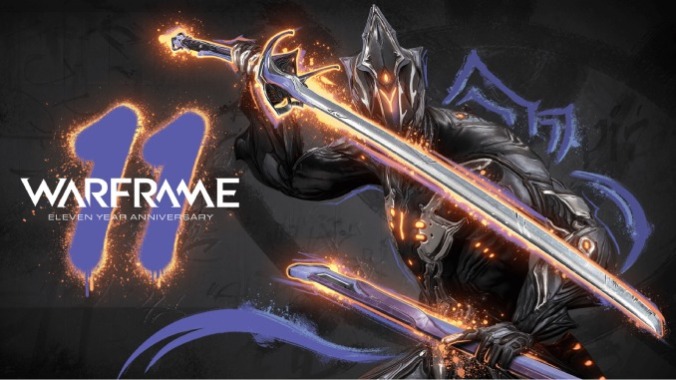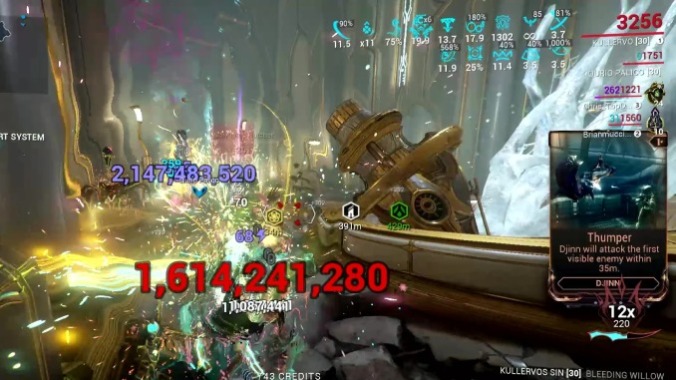
Digital Extremes has done something truly remarkable over the past 11 years. They’ve taken their cool little free-to-play space ninja simulator, Warframe, and evolved it into their most successful title with over 75 million registered players as of 2023. All Warframe has done is grow since its inception. Now, we have conventions dedicated to this game in the form of TennoCon, which is a sold out event this year. Warframe has at least 40,000 concurrent players every single day on Steam alone, sitting high among the ranks of other popular free-to-play titles on Steam such as Team Fortress 2 or Destiny 2. Now they’re spreading out to create more ambitious titles such as the upcoming Soulframe. What is it that makes Warframe even worth talking about after its lackluster release back in 2013? How has it stood the test of time? Why have I had a burning desire to put in over 200 hours just over the last few weeks?
It’s simple: Digital Extremes cares.
It is important to understand a bit about Warframe’s production and how this game came to be. I won’t give you a whole lecture, but enough to understand the rising tide Digital Extremes stood against. Digital Extremes were a work-for-hire company, meaning they made the games by the instruction of an outside studio. Illustrating that example would be their involvement with Epic Games when they had a hand in developing Unreal Tournament all the way back in 1999. However, they were ambitious and wanted to make their name known as a leading studio, so they announced Dark Sector in February 2000—a game that was meant to combine the intensity of Unreal Tournament with the evolution of a character in an MMO. However, their ideas only led them to doing more contract work for other studios. Thanks to the influx of work, Digital Extremes weren’t able to do anything with Dark Sector until 2004, where the entire game could be conceptualized and eventually released in 2008. Now it’s 2011, and nobody was hiring them for any sort of contracts. They’re looking back throughout their portfolio for what to do next, only to see that the original Dark Sector concepts could be reworked as a new IP for a free-to-play title. After this realization, Warframe was then announced to the public in June 2012 with a beta to follow in October. Then came the full release in 2013, and the start of a long journey.
Initially, Warframe really wasn’t doing so well. This was marketed as a free-to-play player versus environment (PVE) shooter, which went against the multiplayer craze of player versus player (PVP), so that’s one audience they’re losing. Journalists don’t typically go crazy for free-to-play games so goodbye to another avenue of advertisement. Publications that did give Warframe attention gave the general consensus of “it’s fine but nothing extraordinary” and that’s exactly how it was. Warframe’s movement was clunky, its shooting lacked impact, and its environments were blander than stale white bread. Plus, it was drawing a lot of comparisons to Bungie’s upcoming Destiny. To be fair, the comparisons between Destiny and Warframe were valid as they are both sci-fi themed action games. The difference being that Destiny is made by Bungie, who’s responsible for the legendary Halo series, and Warframe was just the game with ninjas so most would focus on Destiny by default. People were absolutely playing Warframe, it’s free after all, but it really wasn’t close to profitability until the game became available on Steam. The boost in player count resulted in being able to keep the studio viable for a future, and was able to become a PS4 launch title in November 2013. After gaining more traction over time, Digital Extremes was able to start transforming this game with subsequent updates to change things for the better. Through sheer determination, Digital Extremes took Warframe from the little game that almost could to a game that absolutely did.
What Digital Extremes has done is change the engine to layer actions and animations on top of one another. What this means is none of your character’s actions are isolated and have to be performed one at a time. Regardless of being on the ground, in the air, or aiming down sights, your character can flow like a butterfly just moving to the next objective with the smoothest parkour movement I’ve ever felt. Firing weapons in Warframe feels like piercing through stratospheres, with the blast of a shotgun having enough power to deafen a room or an arrow having enough force to fly through a skull ripping it off its spine and attaching to the wall. Everything Digital Extremes has done contributes to this original vision of a space ninja power fantasy. Anything you want to do can be done with such ease. The game that originally came out in 2013 and the one you can download and play today are incomparable. There has been no other action game I have played that could match the visceral feeling I get when I control my Warframe. Warframe’s combat is the most gratifying ballad of violence I’ve ever had the pleasure of dancing to. The game may be overwhelming to look at in its presentation. It can come off as too much; it could even be considered stressful. That’s only how it looks, though; how it feels is a whole different story. Because of how tight all the movement is, knowing this level of destruction is at your fingertips becomes such a cathartic rush that you cannot get enough of.

Now it’s time to get down to brass tacks. What exactly is Warframe? It’s a simple question but one that doesn’t have an “all in one” skeleton key as an answer. Warframe is a third person action game where you control a Warframe, an exosuit with great power, often referred to as Tenno. Every Warframe unit has their own distinctive identity that specialize in different abilities. I really do mean it when I say that all of them really are unique. Initially the change in a Warframe may not feel like much—say, going from Excalibur to Rhino, which isn’t much of a leap. Now compare Rhino to the brand new Dante. They are similar in the sense that both Warframes can utilize Overguard for extra armor, but they play so vastly different from one another you couldn’t tell especially if you know how they play firsthand. This is one of many parts that contribute to the multi-layered cake that is Warframe.
Downloading Warframe today having never played it before is essentially the first day of college. You have your orientation (the tutorial), then you have to figure out where to go, who’s important to pay attention to, how to feel prepared… it can be a lot. Something to understand is this game is 11 years old now, which means you are diving headfirst into 11 years’ worth of content. The quests new players start off with are the same quests seasoned players experienced way back when, all the while new content is being added on top such as the aforementioned Dante. Understand that I am an avid Destiny 2 player, and I was once Team Destiny over Team Warframe. That also means I had the displeasure of watching Bungie “vault” content such as the Forsaken campaign which in my opinion was one of the strongest campaigns ever crafted for Destiny. Now the problem is new players diving in are going to have missing gaps in the story that are integral to sympathizing with these characters as Forsaken was a massive turning point. I mention this to showcase that Warframe isn’t going to have this problem. It just may come across as a bit much.
It’s easy to take a look at the game’s armory menu and codex entries and easily assume that this game is just nonsensical with its needless lore and predatory microtransactions, but that would be incorrect. All the weapons can be purchased with platinum, the game’s premium currency, or you can just buy the blueprint with credits, the plentiful in-game currency, and create the gun yourself for free. You will have to wait for the gun to be crafted while the game tempts you to spend platinum to speed up the process. Those with patience that can wait out the time can earn everything they could possibly want in the game for free. This includes brand new items such as the recent Gauss Prime pack. His weapons cost $50 alone, but through the mechanic of opening Relics to earn Prime (better) versions of those aforementioned blueprints, I managed to get the parts for one of the brand new guns that came with that $50 pack. It takes patience to learn Warframe’s systems and it refuses to hold your hand. Warframe is not a game that comes to you, you have to go to it. Due to the pure ambition Digital Extremes has had for their game, the systems in place help to make Warframe incredibly enthralling once you understand its wealth of content. No season passes or expansion passes or any of that garbage; those who stick with the journey get to experience Warframe’s story and what a damn good one it is. All the platinum will do is speed up the process for convenience but that’s by no means a requirement to absorb the game’s content.
Through concentrated effort, Digital Extremes managed to create the game they always wanted, while listening to the community and maintaining a reputation for hearing all voices. Of course they are not immune to criticism over changes or characters being nerfed, but Digital Extremes willing to have discussions like this with the community puts Warframe in a league of its own. They hear everyone loud and clear and know that they need to make some changes because the last thing they want is for players to be unhappy and refuse to use the new Warframes. Even with occasional criticisms from its fans, playing Warframe truly feels like a part of something grander. This is how a live service game can survive: by showing your audience that this product is worth caring about. It’s making those meaningful changes and letting the players experience the actual service implied with a live-service title, all while feeling like your voice can impact the direction of the future. This is not a case of “release it broken and fix it later;” it’s about evolution, creating something that resonates and expanding upon it as time goes on. That’s how Warframe has lasted this long, and why there’s no end in sight.
Matthew Reyes is a Paste intern.